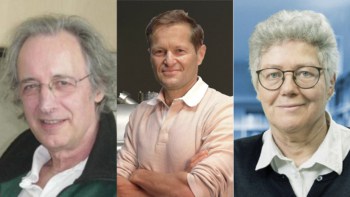
A newly discovered class of materials known as “topological insulators” could help physicists to obtain new ways of defining the three basic physical constants – the speed of light (c); the charge of the proton (e); and Planck’s constant (h). That’s the claim of a team of physicists in the US, which has proposed a new experiment to measure the fine-structure constant (α), which is a function of h, c and e, by scattering light from such a material. Topological insulators are unusual in that electrical current flows well on their surface, but not through their bulk.
The new measurement has been proposed by Shou-Cheng Zhang and colleagues at Stanford University as well as researchers at the University of California at Santa Barbara and the University of Maryland. Although there are many other ways of determining α, their technique is the only method that involves measuring a phenomenon that is quantized in units of α. In principle, this means it could provide an extremely precise metrological definition of α.
A new way of defining h, c and e could then be obtained by combining the value of α with measurements of magnetic flux quanta and electrical conductance quanta in the materials, which both depend on h and e.
Insulators that conduct
The strange properties of topological insulators arise from the fact that the shape – or topology – of the electron energy bands makes it impossible for a surface electron to backscatter. Zhang believes that, under certain conditions, this topology leads to an “exact quantization” of how a material responds to an external field. Physicists are already familiar with similar topological responses, which occur when a superconductor is exposed to a magnetic field – resulting in magnetic flux quanta. It is also seen in the quantum Hall effect, when a 2D conductor is exposed to a magnetic field resulting in quanta of electrical conductance.
The physicists argue that a “topological magneto-electric effect” – whereby an electric field can induce a magnetic polarization and a magnetic field can induce an electric polarization – can occur in some topological materials. Furthermore, the topology of the effect means that the response of the material to applied electromagnetic fields is quantized in units of α.
Rotating incident light
To measure the effect, Zhang and colleagues propose an experiment whereby light is shone at a thin film of topological insulator and the Kerr and Faraday rotations are measured. The Kerr rotation is the shift in the direction of the polarization of the reflected light relative to the polarization of the incident light. The Faraday rotation is the shift in the polarization of the transmitted light.
Both effects involve the interaction between light and matter in the presence of a magnetic field. The physicists have derived a formula that suggests that in some toplogical insulators a certain combination of the Kerr and Faraday angles is quantized in integer multiples of the fine structure constant.
The next step is to try to measure this effect – and Zhang says that three independent labs are currently trying to measure the effect in real materials.
The work is reported in Phys. Rev. Lett. 105 166803.



